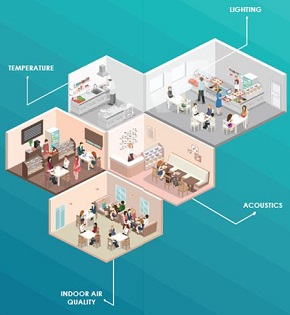BS ISO 17772 - Indoor environmental quality
The main objective of building services engineers and anyone involved in designing a built environment is to create a space conducive to the function of the building. Too often this gets lost in the plethora of other requirements; regulatory, economic and aesthetic.
At BSRIA, we see specifications in which the design parameters are not clearly defined and this frequently leads to gaps between expectation and performance and doubts about whether the completed building meets the client’s requirements. Some specifications indicate winter or summer temperatures, with no mention of tolerances or where the temperatures must be measured.
There are hundreds of useful standards, guides and codes of practice to every aspect of the built environment and of course, BSRIA contributes to this array of publications. But some buildings don’t warrant all the detail from these publications and a basic specification is better than no specification.
A new standard published in January 2018 aims to bring together the key requirements for Indoor Environmental Quality (IEQ) - BS ISO 17772-1:2017 'Energy performance of buildings. Indoor environmental quality. Indoor environmental input parameters for the design and assessment of energy performance of buildings'.
The standard specifies requirements for indoor environmental parameters: temperature, indoor air quality, lighting and acoustics and specifies how to establish these parameters for environmental design. It was drafted to provide a common basis for energy performance calculations but it has wider application as a basic standard for IEQ.
This standard is applicable where the criteria for indoor environment are set for human occupancy and where the production or process does not have a major impact on indoor environment. It includes design criteria for the local thermal comfort factors, draught, radiant temperature asymmetry, vertical air temperature differences and floor surface temperature. It also specifies occupancy schedules to be used in standard energy calculations and how different categories of criteria for the indoor environment can be used.
The criteria in this standard can also be used in national energy calculation methods. It sets criteria for the indoor environment based on existing standards and reports.
It does not specify design methods, but gives input parameters to the design of building envelope, heating, cooling, ventilation and lighting.
The standard defines four levels of IEQ:
- IEQi: High level of expectation and also recommended for spaces occupied by very sensitive and fragile persons with special requirements like some disabilities, sick, very young children and elderly persons, to increase accessibility.
- IEQii: Normal level of expectation.
- IEQiii: An acceptable, moderate level of expectation.
- IEQiv: Low level of expectation. This category should only be accepted for a limited part of the year.
The format of the standard is that the user should define the level of performance required for each parameter, to this end it provides forms to be completed by the user in Annexes A to F. However, in Annexes H to L it provides ‘default values’ for the parameters entered on the same forms and these are likely to be widely used.
Temperature is specified as the ‘Operative temperature’ effectively the mean of air temperature and radiant temperature at the building user’s location in most environments, where the air speed is under 0.2 m/s. Adaptive temperature, the user-acceptable temperature modified by the external temperature over the past seven days, is also recognised as relevant for spaces without mechanical cooling.
This article was originally published here by BSRIA in January 2018. It was written by Colin Pearson, Team Leader, BSRIA Sustainable Construction Group.
--BSRIA
[edit] Related articles on Designing Buildings Wiki
Featured articles and news
Ebenezer Howard: inventor of the garden city. Book review.
The Grenfell Tower fire, eight years on
A time to pause and reflect as Dubai tower block fire reported just before anniversary.
Airtightness Topic Guide BSRIA TG 27/2025
Explaining the basics of airtightness, what it is, why it's important, when it's required and how it's carried out.
Construction contract awards hit lowest point of 2025
Plummeting for second consecutive month, intensifying concerns for housing and infrastructure goals.
Understanding Mental Health in the Built Environment 2025
Examining the state of mental health in construction, shedding light on levels of stress, anxiety and depression.
The benefits of engaging with insulation manufacturers
When considering ground floor constructions.
Lighting Industry endorses Blueprint for Electrification
The Lighting Industry Association fully supports the ECA Blueprint as a timely, urgent call to action.
BSRIA Sentinel Clerk of Works Training Case Study
Strengthening expertise to enhance service delivery with integrated cutting-edge industry knowledge.
Impact report from the Supply Chain Sustainability School
Free sustainability skills, training and support delivered to thousands of UK companies to help cut carbon.
The Building Safety Forum at the Installershow 2025
With speakers confirmed for 24 June as part of Building Safety Week.
The UK’s largest air pollution campaign.
Future Homes Standard, now includes solar, but what else?
Will the new standard, due to in the Autumn, go far enough in terms of performance ?
BSRIA Briefing: Cleaner Air, Better tomorrow
A look back at issues relating to inside and outside air quality, discussed during the BSRIA briefing in 2023.
Restoring Abbotsford's hothouse
Bringing the writer Walter Scott's garden to life.
Reflections on the spending review with CIAT.
Retired firefighter cycles world to raise Grenfell funds
Leaving on 14 June 2025 Stephen will raise money for youth and schools through the Grenfell Foundation.
Key points for construction at a glance with industry reactions.
























